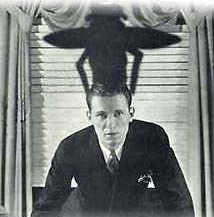
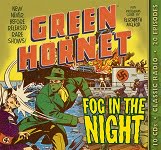 The Green Hornet (1936-1952) aired “Detour to Justice” on September 26, 1943 as its 622nd episode out of over 1,000. The Green Hornet was created specifically for radio by producer George Trendle and director James Jewell. The first episode aired January 31, 1936. The series proved so popular its run lasted sixteen years, with its final episode airing in late 1952. The 1940s saw two movie serials featuring the Green Hornet and his staunch ally Kato (The Green Hornet–1940, and The Green Hornet Strikes Again!–1941), which only served to heighten the popularity of the radio show. Several attempts at Green Hornet movies have been made (most recently in 2011) but none have proved as successful as the radio show (this includes the short-lived Green Hornet TV show from the 1970s, which nevertheless catapulted Bruce Lee to stardom in his role as Kato). Over its long radio run four actors were the voice of Britt Reid/the Green Hornet. From the show’s inception in 1936 through 1943 Al Hodge (1912-1979) was the voice of the Hornet (photo top right). In later years he would take on the role of Captain Video (1950-55, photo lower right) for the early television show Captain Video and His Video Rangers (1949-55), the first show of its kind on American television.
The Green Hornet (1936-1952) aired “Detour to Justice” on September 26, 1943 as its 622nd episode out of over 1,000. The Green Hornet was created specifically for radio by producer George Trendle and director James Jewell. The first episode aired January 31, 1936. The series proved so popular its run lasted sixteen years, with its final episode airing in late 1952. The 1940s saw two movie serials featuring the Green Hornet and his staunch ally Kato (The Green Hornet–1940, and The Green Hornet Strikes Again!–1941), which only served to heighten the popularity of the radio show. Several attempts at Green Hornet movies have been made (most recently in 2011) but none have proved as successful as the radio show (this includes the short-lived Green Hornet TV show from the 1970s, which nevertheless catapulted Bruce Lee to stardom in his role as Kato). Over its long radio run four actors were the voice of Britt Reid/the Green Hornet. From the show’s inception in 1936 through 1943 Al Hodge (1912-1979) was the voice of the Hornet (photo top right). In later years he would take on the role of Captain Video (1950-55, photo lower right) for the early television show Captain Video and His Video Rangers (1949-55), the first show of its kind on American television.

The Green Hornet’s real identity is Britt Reid, publisher of the Daily Sentinel. During a visit to the Far East, Reid saved Kato’s life. Kato now links his fortune to that of Reid as a faithful companion, driver of the Black Beauty (forerunner of the Batmobile), and all-around aide-de-camp. (Cover at left from The Green Hornet #6, August 1940.)
In the 1930s America was rife with criminal organizations, and not only they, but the common criminal element led to many a radio show featuring crime fighters of various stripes. Of those shows featuring crime busters with secret identities, or a special ability or power, or who employed scientific or advanced technology to thwart criminals, perhaps the most popular trio was Dick Tracy (1934-48), The Green Hornet (1936-52), and The Shadow (1937-54). To place the popularity of these “special” crime fighter shows (as opposed to straight detective or police programs, of which there were many) in some sort of perspective, the Great Depression lasted from 1929-39. During this difficult time the underworld took advantage of a ruined economy in any way it could, including bootlegging illegal alcohol during the era of Prohibition (1920-33). While this was but one enterprise crime families adopted, their schemes and violence were felt in many areas of public life. Al Capone was probably the most well known crime family boss of the time, but by the time The Green Hornet program hit the airwaves Capone was himself out of the picture, having been sent to a Florida prison in 1931, where he would die eleven years later. But crime and crime families continued without Al Capone. Scams, cons, local crime gangs, and any number of rackets bent on cheating the public or enriching one’s own pockets abounded (as they do today). But during World War II another sort of evil would concern the American public and the Green Hornet…Nazi spies!
And speaking of Nazi spies, look no further than this episode, “Detour to Justice.” War tests the best in men and exposes the worst. This tension-filled story pits two German brothers against one another with the initial results not what you might expect. The Green Hornet must quickly plot a scheme to set things right, but the odds are slim, and the plan fairly complex and potentially dangerous. But a man’s life is at stake, time is of the essence, and failure is not an option. A perfect scenario for the Green Hornet as he takes a “Detour to Justice.”
Play Time: 29:17
{Late September of 1943 found the neighborhood gang reluctantly back in school, the only thing buoying their spirits their weekly meeting at the corner newsstand. Captain Future (1940-44) was at the height of its crudely written but imagination rich space opera adventures and just the thing to make a young mind forget the dreariness of the classroom. Though named on the cover for full length novels as being written by Brett Sterling, insiders knew that this was just a pseudonym for one of the most popular early space opera writers in the field, Edmond Hamilton. Captain Future would publish 17 issues overall, 3 in 1943, and but 2 more in 1944 before it folded. Famous Fantastic Mysteries (1939-53) laid its claim to fame on publishing classic material, thus fulfilling a vital function. The fact that it ran for a good, long run of 14 years is testament to the void it filled. In 1943, when many magazines felt the war time paper shortage and folded, others would survive by cutting issues and FFM was no exception, seeing but 3 issues on the stands in 1943. The Phantom Detective (1933-53) also wore a mask as did the Green Hornet and also fought crime in similar ways. It was a solid monthly through 1941, but during the war had to drop a few issues a year. 1942 saw 8 issues and 1943 only 7, but it would stabilize to a bi-monthly schedule in 1944 and remain so for most of the remainder of its existence until it went quarterly in 1950 and remained so until its final issue in 1953.]
[Left: Captain Future, Summer ’43 – Center: Famous Fantastic Mysteries, Sept. ’43 – Right: Phantom Detective, Oct. ’43]
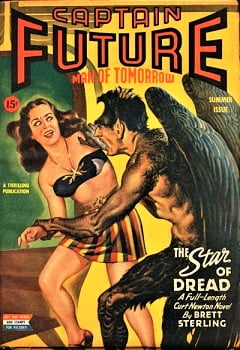
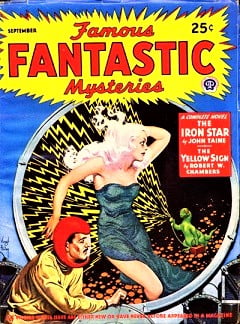
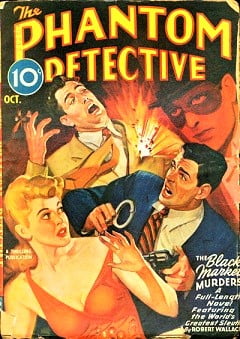
To view the entire list of weekly Old Time Radio episodes at Tangent Online, click here.